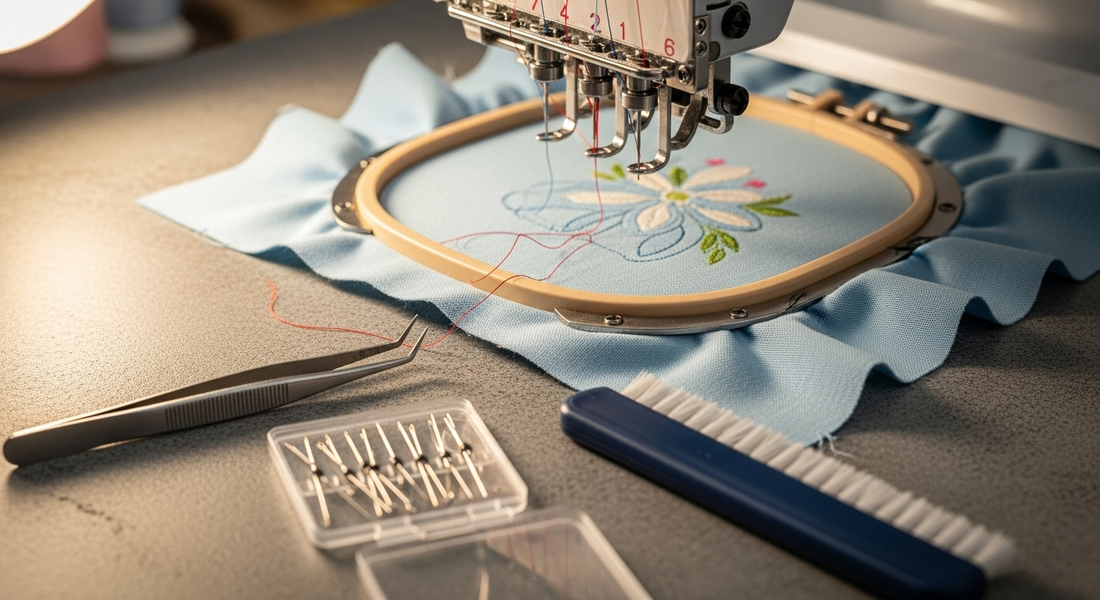
Thread Breaks and Skipped Stitches - Why They Happen and How to Fix Them
Share
Nothing kills your embroidery momentum like thread breaks. You're cruising along, design looks great, and then SNAP. Or worse, you finish a design only to find it's full of holes where stitches got skipped. I've been there countless times, and I've learned that most of these problems are actually pretty simple to fix once you know what to look for.

Thread Breaks - The Usual Suspects
The Needle is Your Enemy (Sometimes) Nine times out of ten, when thread keeps breaking, it's the needle. Even if it looks fine, change it. I used to try to squeeze every last project out of a needle, but now I just swap them out at the first sign of trouble.
Dull needles don't cut through fabric cleanly - they punch and tear, which creates friction and heat. That heat weakens the thread until it snaps.
Threading Issues You Probably Don't Think About Threading seems simple, but there are little things that matter. Always thread with the presser foot UP - this opens up the tension discs. I learned this the hard way after fighting with tension for hours.
Check your thread path too. Sometimes thread gets caught on rough spots or isn't sitting properly in the guides. I run my finger along the thread path every time I rethread.
Tension Problems - The Tricky One Tension is the mysterious black magic of embroidery. Too tight and the thread breaks. Too loose and you get loops and mess.
Start with your manual's recommended settings, then adjust slightly. For thicker threads or metallics, loosen the tension a bit. For thin threads, tighten it up.
Your Thread Might Be Garbage Cheap thread is expensive in the long run. I used to buy whatever was on sale, then spend hours dealing with breaks and poor stitch quality. Good thread costs more upfront but saves you so much frustration.
Old thread gets brittle too. That spool you've had sitting around for two years? Probably not worth using on an important project.

Skipped Stitches - The Silent Killer
Needle Problems Again Bent needles are the #1 cause of skipped stitches. Sometimes you can't even see the bend - the needle looks fine but it's just slightly off. When in doubt, change it.
Wrong needle type matters too. Ballpoint needles for stretchy fabrics, sharp needles for woven stuff. Using a regular needle on knits will cause skipped stitches all day long.
Hooping - Tighter Than You Think Loose hooping is probably the second biggest cause of skipped stitches. The fabric moves just enough to throw off the needle's timing with the bobbin hook.
But don't over-stretch either, especially with knits. You want it snug and stable, not stretched out of shape.
The Take-Up Lever - Don't Ignore It This little thing needs to catch the thread on every stitch. If the thread isn't properly seated in the take-up lever, you'll get skipped stitches randomly throughout your design.
Lint and Debris - The Invisible Problem Clean your machine more than you think you need to. Lint builds up in the bobbin area and throws off the timing between the needle and hook. I clean mine every few hours of stitching now.

What Actually Works - My Prevention Routine
Change needles religiously. Every 6-8 hours of stitching, or immediately if I hit a pin or thick seam. I keep a bunch of needles handy and don't think twice about swapping them.
Clean the machine weekly. Sounds like overkill, but lint accumulates faster than you think. A few minutes with compressed air saves hours of troubleshooting later.
Use the right stabilizer. Fabric moving around causes all kinds of problems. Too little stabilizer and things shift. Too much and you get puckering.
Don't run too fast. I know you want to finish quickly, but high speeds create more friction and stress on everything. Find the sweet spot where your machine runs smoothly.
Store thread properly. Keep it away from direct sunlight and moisture. I learned this after a whole box of thread went bad from sitting in a damp basement.
When Simple Fixes Don't Work
Sometimes you do everything right and still have problems. That's when you need to think about machine timing - the synchronization between the needle and the bobbin hook.
This isn't something you can fix yourself. If you've tried new needles, cleaned everything, checked your threading, and you're still getting consistent skipped stitches, it's time for a service call.
The Real Talk
Most thread breaks and skipped stitches are caused by simple stuff - dull needles, poor threading, or dirty machines. I probably wasted weeks of my life trying to fix these problems with complicated solutions when all I needed was a new needle.
Keep a troubleshooting checklist handy:
- Change the needle
- Re-thread completely
- Check the bobbin area for lint
- Verify hooping tension
- Try a different thread
Fix these basics first before you start messing with tension settings or blaming your machine. Most of the time, that's all you need.